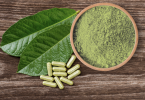
Shutterstock
The DEA’s deadline for placing kratom alkaloids on the schedule 1 controlled substance list grows closer, and the outpouring of support for the ancient plant grows louder. More than 130,000 people have signed a petition on WhiteHouse.gov to keep kratom legal. The kratom community in the U.S. is coming out in force to oppose what it views as government overreach that will endanger lives.
The effort is drawing attention in high places. Two congressmen have penned a “dear colleague letter” asking that the DEA ”delay a final decision on the placement of kratom as a schedule I [and] provide ample time for public comment on this significant decision,” which the agency has so far declined to do. Congressmen Mark Pocan (D-Wis.) and Matt Salmon (R-Ariz.) drafted the letter that will be circulated to every member of Congress. The kratom community is now reaching out to their representatives to sign onto the Pocan-Salmon letter.
Also on Forbes:
The DEA has justified its plan by citing stats showing a reported increase in calls to poison control centers involving kratom. These were published in a CDC weekly report in July that seems to have been at least partially a trigger for what’s happened since. The DEA also cited 15 deaths between 2014 and 2016 the agency says are attributable to kratom use. Since these stats are at the core of the schedule 1 plan, they deserve closer attention.
When you investigate the stats, and slog through online forums where people discuss their experiences with the plant, a couple of trends emerge. One is that the potential for harm is highest when someone is ingesting kratom with other substances. When someone who has taken kratom overdoses, it’s typical for a toxicology report to show they were also using other drugs, and the question then becomes which substances triggered the overdose. Accounts of kratom-only overdose are exceedingly rare, and some would argue they simply don’t exist. Fourteen of the 15 alleged kratom-related deaths cited by the DEA involved other drugs, as reported by NPR.
The other trend is that people experiencing negative outcomes with kratom are often using concentrated extracts, many times more potent than the traditional powdered leaf material. Some sellers of kratom have exploited their extract product lines (like high-dosage liquid tinctures) with predictably bad results. No question, these elements of the marketing and selling of kratom haven’t done this ancient medicinal plant any favors.
Having said that, the situation isn’t far removed from that of our favorite legal drug, caffeine. Drinking a cup of coffee will reliably provide the caffeine boost we all know well, with some downsides. Drinking a concentrated caffeine product will provide a more acute effect and worse downsides. Drink enough of the concentrated form and the downsides can quickly become severe. At least 34 people are documented to have died in the U.S. from overdosing on caffeinated energy drinks since 2004.
Same principle applies to nicotine. It’s entirely possible to experience overdose-type effects from ingesting too much nicotine, and if you’re not a regular smoker it won’t take much. If you have trouble believing that, light up a nice fat cigar and inhale a few times. After the coughing fit is over, you’ll find yourself dizzy and nauseous. That’s a relatively mild form of nicotine toxicity at work, and it can get far worse (I’m not recommending you actually try that, but you get the point).
Of course the most obvious example is alcohol, the effects of which need no elaboration. People die from alcohol poisoning in the U.S. every single day–by midnight of whatever day you’re reading this, six more will have died. In the 30-day period between the DEA’s announcement and the scheduled ban on kratom, 180 more people will have died, to say nothing of the number of deaths from alcohol-related accidents.
With caffeine, nicotine and alcohol we accept that consumers must exercise personal responsibility in using the products, and we know that a certain percentage of consumers will not. For good or bad, that’s life in an open society with a free market. We don’t punish the majority of responsible consumers for the missteps of the minority.
Unlike nicotine and alcohol, and more profoundly than caffeine, kratom actually provides its responsible users with benefits, often for people who felt like they’d run out of options. I covered this point in my previous article but it bears repeating: read the personal testimonials and you’ll see one after another report that kratom was the last hope in a battle against drugs that were killing them, and to treat pain that was driving them to life-long addiction. For those people, this is about life and death.
A final few words are worth mentioning on what is perhaps the most difficult angle of this story to flesh out: conflicting interests. Because kratom alkaloids have documented benefits related to treatment of pain and mitigating the nightmare of opioid withdrawal, you might assume they’ve attracted the interest of those vested in the invention and sale of new pharmaceuticals. It doesn’t require a conspiratorial stretch to find evidence of this interest. For example, a patent was filed in 2008 on various methods employing kratom alkaloids to overcome opioid withdrawal: Methods For Treating Withdrawal From Addictive Compounds: US 20100209542 A1. You can dig into the details on that Google patents page, but it’s worth calling out a couple of lines from the abstract:
Kratom (Mitragynia speciosa korth) is recognized increasingly as a remedy for opioid withdrawal by individuals who self-treat chronic pain and/or generalized substance abuse….The present invention contemplates that Kratom extract may also be useful for the treatment of other addictive drugs besides opiate derivatives.
The original patent assignees include the University of Mississippi, the same institution that has the contract controlling the national supply of marijuana used in medical research.
And research has been conducted specifically investigating the efficacy of using kratom alkaloids as prescribed pharmaceuticals. An especially notable 2014 study concluded: “The pharmacokinetic linearity and parameters reported are necessary pharmacological information of kratom, and there is a possibility for it to be developed medically as a pain killer or better opioid substitute in the future.”
Other breadcrumbs along this same trail are out there, and while not conclusive, they raise questions about growing interest in turning kratom alkaloids into prescription drugs. If that is the goal, it would seem incompatible with kratom being available to any adult who wants to buy it.
How this information ties into the DEA plan to schedule 1 kratom, if it does at all, is debatable, and reasonable people can draw conclusions in more than one direction. What isn’t debatable is that in just a few days a plant that an enormous community uses for a variety of reasons—many who say their lives depend on it—will be removed from the free marketplace and made illegal. Congress intervening is the greatest hope for forestalling the action and allowing the public a voice that is so far being denied.





